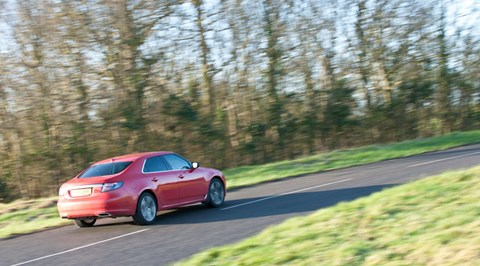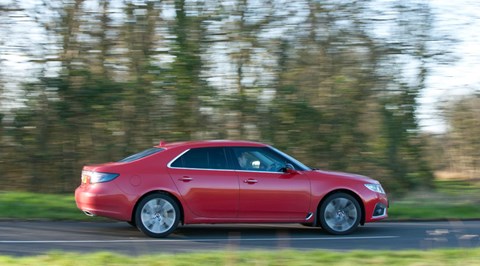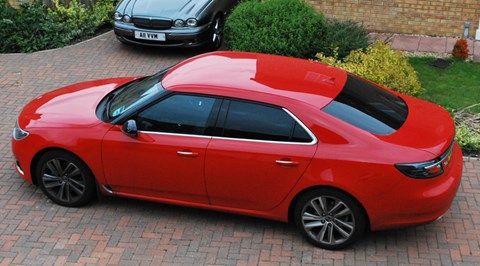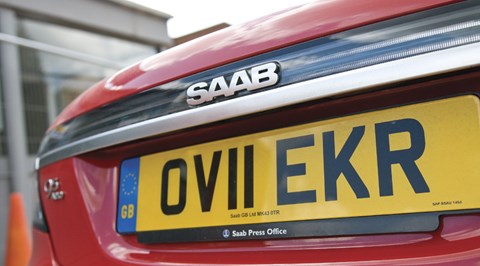The final good-bye – 20 March 2012
Finally, after a delay of nearly three months, Saab’s administrators turn up to reclaim our long-term test car
This is the last will and testament of Saab 9-5, registration OV11 EKR. I’ve written about this car more than any long-term test car I’ve ever driven, and it’s probable that all of us – me included – are a bit tired of it by now.
But this has been a unique situation. The 9-5 was delivered personally last spring by Saab’s enthusiastic UK managing director, full of effusive bravado and excitement for the future. He ribbed us about our choice of bright red paint and warned us about the possible perils of locking the key in the boot. We asked about the already swelling storm clouds over Trollhättan, but he was bullish, upbeat, dismissive of the naysayers. Yet less than 12 months later, the company has gone down, vanished. It’s a Titanic moment – hard to comprehend that it’s actually sunk.
So I just want to draw a line under OV11 EKR. It had been earmarked for collection in early December, but nobody came. We didn’t quite know what to do, but were assured by the outgoing Saab PR manager (a big shout here to Jackie Allard, who did sterling work in an increasingly impossible situation) that the administrator was aware that we had the car and would be in touch.
Christmas passed, then new year, then January… still nothing. And the car’s oil change warning light was flashing like a good ‘un, despite the fact that, with 12,000 miles up, no service was remotely due. So, I took it to the Saab dealer – Marshall of Peterborough and found the doors locked. A sign said: ‘For assistance please go to Chrysler Jeep showroom opposite.’ I felt the desolation of the Saab owner – the knowledge that there’s nobody home.
Marshall serviced the car for me (invoiced as an 18,000-mile service carried out at 12,234 miles) and liberated £306.64 from my wallet. Slightly painful, given that the car should have been long gone by now.
Then, on 21 February I was contacted by GMAC Plc, which was the finance company for Saab prior to its administration. The company explained that it had ‘full title to the vehicle under the terms of its security’, and demonstrated this by confirming it held both the V5 and the spare key. Showing epic good manners they asked whether, at a suitable time and date for me, it would be okay for them to collect the car.
A date was arranged, but still they didn’t come – the transporter developed an electrical fault, apparently. Oh, the irony. Finally, nearly another week later, OV11 EKR was trucked out of the CAR HQ car park.
And into history.
By Greg Fountain
Spoilt for choice – 8 February 2012
When a bloke who works for a car mag says he’s ‘between long-term test cars’ it’s usually like when an actor says he’s ‘resting’ – ie, nothing doing. But mine is the opposite problem – my Saab hasn’t been collected yet and our Jaguar XF has been passed to me for safekeeping.
This wasn’t planned, but there are some compelling similarities between the two cars, and Saab was certainly thinking about XF customers as potential targets when it launched the 9-5. Was it kidding itself? It’s closer than you might think.
Both cars are mid-sized four-door saloons powered by four-cylinder diesel engines. The Jag’s 2.2-litre has 190bhp and produces a throaty 332lb ft of torque, which feels surprisingly sprightly considering that it’s lugging around a 1745kg car loaded with leather and slightly dodgy wood. The Saab runs it close on power, with 187bhp, but is woefully down on torque, with just 258lb ft on offer. With 1885kg to haul it’s always going to feel slower than the Jag, although it justifies that weight by being longer (5008mm vs 4961) and by being so much more spacious inside it’s like another class up.
The two cars are incredibly close on performance figures. XF is quicker to 62mph by just 0.3sec (8.5 beats 8.8) but tops out 3mph behind at 140mph. That’s the data, but subjectively the Saab doesn’t feel any slower to 62 – both cars are rubbish at getting themselves off the line, but once up there it’s neck-and-neck. The Jag rides better, though, and feels more refined generally.
Planet-wise the Jag wins out on fuel consumption, its 52.3mpg beating the Saab’s 47.1, but the Saab counters with 142g/km CO2 against the Jag’s 149.
And the Saab scored a big fat victory when the snow and ice descended this week, easing its front-wheel-driven way out of my drive where the XF impotently spun its driven rear wheels.
This is pretty much a dead heat, but for two things. First, I’ve barely had chance to get to know the XF yet, and it’s a car that looks like a slow burn to me (which it jolly well should be at £7k more than the 9-5). And second, Saab is dead, the 9-5 is history, and even if it were the better car you couldn’t choose it instead of a Jaguar.
So close, Saab, and yet so far.
By Greg Fountain
The Saab 9-5 is still here! – 23 January 2012
 In case you hadn’t heard, Saab is dead. But our Saab 9-5 2.0 TTiD Aero long-term test car is neither dead nor showing any signs of deadness. Death. Whatever.
In case you hadn’t heard, Saab is dead. But our Saab 9-5 2.0 TTiD Aero long-term test car is neither dead nor showing any signs of deadness. Death. Whatever.
No, in fact, the perception of the 9-5 at CAR HQ is doing what Saab used to do jolly well in the days of Erik Carlsson: rallying. You’ve heard of the dead cat bounce, yes? Well here’s the dead Saab bounce, a phenomenon in which a car that had been slightly underwhelming suddenly starts to take on a strange allure once it’s imperilled. Have you ever dumped your girlfriend for several sound reasons, and then immediately started thinking how lovely and attractive she is? Or quit your stressful job and then instantly started enjoying it? No? Just me then.
But I’m now approaching the long (VERY long, in fact, at 5008mm) red saloon with a sense of increased affection and delight. It’s always been a good-looking car, the 9-5, and I reckon we got the wheels right too (19in Edge alloys at £105 a corner). Which helps. But now I’m looking at those architectural hindquarters, those graceful 900-alike C-pillars, that raked roofline, and I’m starting to wish we could keep the car for good.
Inside, too, it’s becoming more pleasurable, as the black leather upholstery settles into that 12,000-mile bagginess that you just know won’t change again for another 100,000 miles.
Luckily, before we get carried away on a cloud, there’s still the grotty diesel engine – that carbuncle which reminds me every morning and every evening how GM has screwed up, big time. If Achilles had been a 9-5 then we’d be talking about Achilles’ engine, not Achilles heel.
Finally, keep an eye on the fuel consumption. I can’t explain why but it keeps getting better. Back in the November 2011 issue I was returning 34.4, which in itself wasn’t bad against a claimed 37.2. Now I’m inching towards 38 and rising. Saab’s epitaph might be this: ‘The first car I’ve ever driven that returned a better-than-claimed mpg’.
By Greg Fountain
Driving the Saab 9-5 on the day the company collapsed – 20 December 2011
 Drove home in Greg’s Saab 9-5 last night, feeling sad. Yesterday’s news that Saab has finally – inevitably – filed for bankruptcy didn’t come as a surprise, but I for one will miss Saab from our GBU data pages. Last night’s drive reminded me why.
Drove home in Greg’s Saab 9-5 last night, feeling sad. Yesterday’s news that Saab has finally – inevitably – filed for bankruptcy didn’t come as a surprise, but I for one will miss Saab from our GBU data pages. Last night’s drive reminded me why.
Our red 9-5 was a beacon of hope for Saab. It’s far from best in the executive class, but it provided a great alternative to the German hegemony.
Here is a big saloon with space in abundance and a conservative style which is discreet and neat. It looks particularly good from the back at night time, that horizontal LED bar lighting up the width of the car.
It’s a big car, the 9-5 – the room on offer is frankly gargantuan. And on a winter’s night like yesterday the typically Swedish thoughtfulness shone bright. The heated seats were searingly hot in seconds, unlike the lukewarm efforts in my Infiniti M35h. The windscreen defrosted quickly. The superb seats need little introduction. Such practicalities make life onboard so much easier.
But putting the 9-5 in context, it’s also clear to see where the pennies were pinched. While I respect the design DNA and thoughtfulness, dynamically the 9-5 is some way off the pace. And it’s virtually all to do with the GM technology that Detroit is so keen to protect.
There’s a rich irony here. General Motors essentially scuppered Saab by blocking the planned sale to Chinese suitors – claiming that its intellectual property was at competitive risk in one of its biggest markets. But firing up the 2.0 TTiD reminds us why that was an optimistic claim.
This GM four-cylinder diesel is some way off the pace, chugging and rattling like a diesel from the old school. Our 9-5 weighs the wrong side of two tonnes – just – and performance is weak. The manual gearchange is long and notchy, too. And just to seal the belief that it’s not as well engineered as it could be, the digital read-out last night knocked out a Jackanory-spec tale of wrongly inflated tyre pressures and open boot warnings the whole way home. (We’ve checked, and the tyres are fine, the boot was safely shut).
It’s a neat summary of what went wrong at Saab. The 9-5 had promise, but was slightly under-cooked. I happen to believe that the new management at independent Saab had the inspiration to turn Saab into a force for good once again. It’s just a bitter shame that they didn’t have the funds to make it happen.
Bye bye, Saab. We’ll miss you around CAR HQ.
By Tim Pollard
The Saab 9-5 as a long-distance cruiser – 19 September 2011
 Borrowed Greg’s 9-5 for the weekend, as we had a family trip down to the south coast – and the 9-5 is simply vast. Apart from our new VW Touareg, the Saab is now comfortably the roomiest car on CAR Magazine’s fleet. I predict keeper Greg Fountain will find his keys in demand in the year ahead, as those of us with less practical cars compete for the space wagons.
Borrowed Greg’s 9-5 for the weekend, as we had a family trip down to the south coast – and the 9-5 is simply vast. Apart from our new VW Touareg, the Saab is now comfortably the roomiest car on CAR Magazine’s fleet. I predict keeper Greg Fountain will find his keys in demand in the year ahead, as those of us with less practical cars compete for the space wagons.
The 9-5’s boot is a good shape and we easily slotted bags for a family of four in, lashing some of the stuff down with the aeronautical holding system. But more impressive is the space in the cabin. It’s like a Skoda Superb in here, the 9-5 stretching out to a faintly ludicrous 5008mm long. In layman’s terms, that means gargantuan legroom front and back. Even man mountains like Ben Pulman and Georg Kacher will stretch out in here.
Ours is the more powerful 2.0 diesel 9-5, with 187bhp for plenty of shove on motorway journeys. It’s a bit rattly at low speeds, but once on dual carriageways the clatter disappears. I still find manual executive cars a bit strange – the vast majority of cars in this A6/E-class sector are automatics – but again this is less of a problem on the M-way. The gearchange itself will certainly win no awards for snicketiness.
Brimmed with diesel, the Saab 9-5’s range climbs to a comforting figure somewhere between 500 and 600 miles, depending on how you’ve been flogging it. Being a night trip, I fiddled with the Night Panel for that classic dulled-down aesthetic in the cabin (reminds me of the War black-out; actually works well, focusing your concentration) and enjoyed the DAB digital radio which gave access to the England cricket team’s final one-day endeavours.
This car retains the Saab virtues of old: comfy seats, straightforward ergonomics (though some of the small buttons on the centre console are VERY fiddly) and a wholesome design. I admire the look of the 9-5 outside; it’s distinctive, large and classy. As Greg says, it cuts a dash in its pillar box red. The interior feels some way off the class best in quality and attention to detail, but it’s a comfy place to while away long drives.
We’re about to find out just how much of a real Saab the 9-5 is. On the strength of this weekend’s trip, I’d say it’s a fine long-distance companion.
By Tim Pollard
Saab 9-5 hello – 15 August 2011
 Today we welcome a Saab 9-5 saloon in Aero spec onto the long-term test fleet. First let me say something on behalf of the very nice people at Saab GB: sorry about the colour. That’s THEM being sorry, incidentally, not ME.
Today we welcome a Saab 9-5 saloon in Aero spec onto the long-term test fleet. First let me say something on behalf of the very nice people at Saab GB: sorry about the colour. That’s THEM being sorry, incidentally, not ME.
I love the colour. I got onto the Saab website car configurator and went through the choices like a somewhat overweight schoolboy. Arctic White? No. Carbon grey metallic? Too gloomy. Java metallic? That’s brown, isn’t it? Silver, either Glacier or Diamond? Too predictable. Oak metallic? Now that really IS brown. Laser Red? That’s it! The ONLY bright colour in the palette of a manufacturer that once thrived on surprising and amazing us. In school Paul Brummell’s dad had a YELLOW 99 (and Paul’s now Her Majesty’s man in Barbados, so it didn’t do HIM any harm). Anyway…
Saab think the colour doesn’t flatter the car. ‘Makes it look blobby,’ apparently. Seriously, they tried quite hard to dissuade me (‘We have to sell it on once you’re done with it!’). But I was unrepentant. If it looks like a fire engine then so what? Fire engines are cool.
Next the wheels. Turbine or Edge? The standard 19in Turbine nods blatantly to Saab’s fast-disappearing aircraft heritage, but those 19in Edge wheels are the absolute badger’s. A snip at £105 a set (set, geddit?).
Upholstery: black leather, natch, to go with my long winter coat. The coat was £275 in the sales, the Saab seats were exactly £800 more. That’s right, £1075. The Convenience Pack (auto folding mirrors, auto-dimming exterior mirrors, keyless entry) costs an inconvenient £360. And I added various non-extravagant essentials such as a DAB radio (£310), cargo rail in the boot (£125), rear-seat side airbags with rear seatbelt pre-tensioners (£205), tyre pressure monitoring system (£105) and – crucially – dark tinted rear and side windows, for full-on drug-dealer/minor celeb effect.
Next, entertainment! Give it up for the Harman/Kardon Dolby 5.1 Surround Sound audio system with 11 speakers. Well, when I say ‘give it up’, I mean give up £565. Ah, yes, and then there’s the sat-nav, with 8in colour touchscreen, six-channel audio output, TMC, hard disc map data storage and 10GB hard disc music storage, all for £1230. Which is pretty good, actually.
And finally the most important part: Drive Sense, the chassis control system that offers continuous damping control, variable effort steering and a choice of three settings: Comfort, Intelligent and Sport. For £975. Ride quality isn’t a Saab USP, so we’re going to need all the help we can get.
Did I forget the engine? It’s the more powerful of the two tunes of the 2.0-litre turbodiesel (187bhp rather than 158), with front-wheel drive rather than four-wheel drive (sorry, ‘XWD’) and in Aero spec. List price: £32,175. As tested: £37,950.
A lot of money but for a lot of car. Let’s hope Saab lives long enough for us to take this test to the distance.
By Greg Fountain